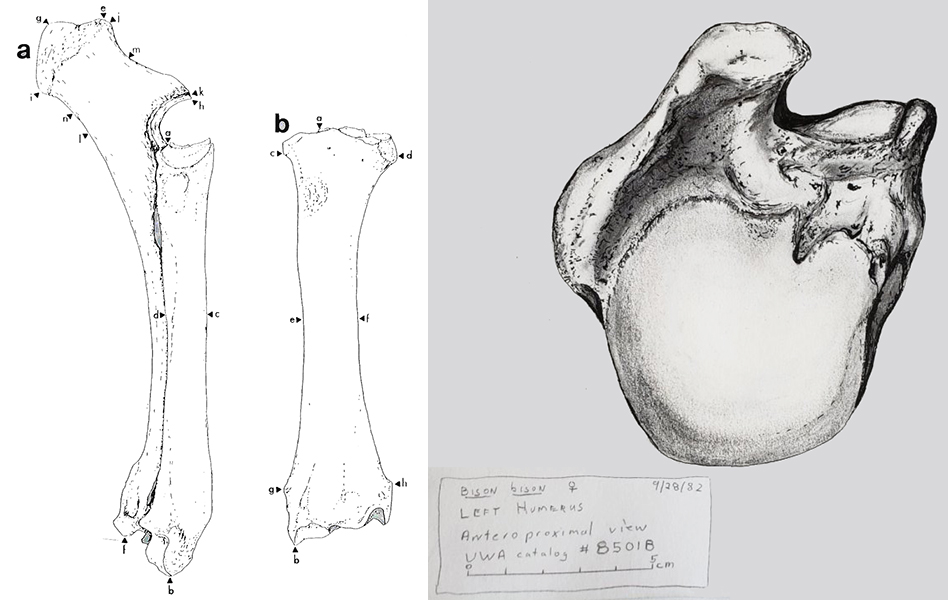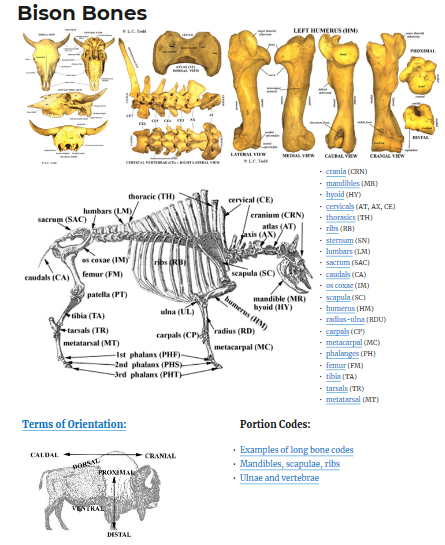8 July 2020: 8:00 AM (approximately 1 hour)
Join Zoom Meeting:
- Meeting Cancelled.
- Meeting ID:
- Password:
NOTE: the ZOOM event will be showing examples of human bones using a plastic replica of a skeleton. These are not real human bones, but a “bone clone” used for teaching and demonstrations such as this. The bison specimens are, however, real bones.
One of the messages of this lesson is that to understand the world in which past peoples lived we need to study and learn about other’s living in that same world. These lessons are a starting point in looking at the diverse types of bones sometimes found in archaeological sites. Human bones are rare in Wyoming sites, but in order to really learn the bones of other animals, it’s important to start with the fact that all vertebrates have the same basic structure. This is one of those rare chances to learn on set of things (bones) that can be translated to every other animal with bones on earth.
Activities:
One of the really nice things about learning bones is that once you learn the names and locations of bones in one animal, you know the basic structure of every other animal on the planet. Learning to correctly identify if the bone is human or bison takes more work, but you should very quickly, for example, be able to say “that’s a humerus” or “that’s clearly a left femur.”
- Print out the human skeleton drawing and start learning the names of the bones in your skeleton (remember, you’ve always got a “library of bones” with you).
- Visit the E-Skeletons website and take a closer look at bones from several other primates or visit E-Lucy and look at the bones from a famous ancestor.
- If you have a pet or other animal in or near your home, take a look at them and see if you can identify which bones go where. Ask things, like “where’s my dog’s tibia?”
- When you’re out walking, pay attention, look for bones. When you find one, practice your drawing (in your field notebook), and see if you can identify. Can you identify parts — where’s the poximal end? Is it from the left or right side? What sort of animal do you thing the bone comes from?
- If you get a chance to visit someplace like the Draper Museum of Natural History in Cody, try to find as many different bones as possible.


NOTE: If you are walking on the Forest or other areas that are grizzly habitat, DO NOT approach or spend time near a carcass.

The study of bones is called osteology and archaeologists who specialize in study of animal bones from sites are often called zooarchaeolgists. One of the first steps in learning zooarchaeology is to know the names of bones and their locations in the vertebrate body. Examples of using skeletons of two species are given here – bison since they are one of the most common types found in Wyoming archaeological sites, and humans, since each of you has one of these skeletons with you at all times.
This on-line session will introduce you to the study of bones from archaeological sites and answer your questions. Here are some webpages to visit to prepare for the class.
Bone locations and terms of orientation

Learning bones
For a more detailed examination of each bone in the human (and other primate) body, visit the E-Skeletons website:
Most individual bones of the bison skeleton, with major landmarks labled can be found at the bison bones page. You can also download a full series of labled photos of the main bison bones as a pdf file:
You can also download a bison/human skeleton comparision pdf:
Here’s an example of an archaeological site in Nebraska where being able to “read the bones” is key to trying to figure out what happened in the past. Just finding artifacts and bones, does not answer all questions. And often, the closer you look at an archaeological problem, the more complex it becomes. The point of this Hudson-Meng story is not “what happended there,” to which the most honest answer is going to be “I’m not sure, but here are the questions the data are prompting me to ask.” That’s archaeology in a nutshell, we are always trying to improve our methods to read information about the past, and then with every new method having to think about our interpretations again. Archaeological science is a great opportunity for life-long learning.



